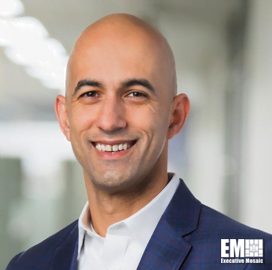
Aydin Mohtashamian
COO
Parry Labs
Executive Spotlight: Aydin Mohtashamian, Chief Operating Officer at Parry Labs
Aydin Mohtashamian, chief operating officer at Parry Labs, recently participated in an Executive Spotlight interview with the Potomac Officers Club to talk about improving federal acquisition processes, developing talent within an organization, better serving our country’s warfighters and more. Mohtashamian previously served in the U.S. Army, and his private sector career includes time at L-3 Communications (now L3Harris) and QinetiQ’s U.S. arm, where he most recently served as president of C5ISR Solutions.
What can you tell us about your background and how you’ve been able to adapt to the ever-changing challenges of the federal landscape over the course of your career?
“After spending eight years in the Army, I worked at a large defense contractor for ten years. I had the opportunity to work on large, complex programs and really learned how to deliver critical systems through a regimented system engineering process. As I surveyed the rapid progress of technology in the commercial sector, I realized many of the programs of record we were executing were not keeping up with the pace of technology. I saw the programs struggle to be descriptive in their requirements, agile in execution and forward-leaning in technology. There was a demand for partnership with our government customers — to support them in defining needs and use cases instead of inflexible technical requirements. It was a clear demand for agile development and rapid technology insertion without sacrificing quality or mission safety. I realized my customers, and the end users in the field, were aligned with achieving the best program outcome while trying to navigate a highly stultified acquisition system geared towards buying large platforms and legacy systems.
This desire led me to start working with smaller, more innovative companies that could embrace agile flexibility instead of the extensive bureaucracies and laborious government acquisition process we had grown accustomed to. Today’s small businesses focusing on technology and innovation are leading the way in challenging the status quo. I have found scaling these businesses to work successfully within the DOD acquisition cycle has been greatly fulfilling for me as a leader. It has also provided great satisfaction in helping our great men and women in our armed forces receive the systems they need to maintain a competitive edge over our adversaries. Innovation is about culture and networks, not silos and hierarchy. It can be found in any size company, but in today’s DOD acquisition, much of the innovation is being delivered by non-traditional small- and mid-tier businesses.”
How would you describe your management style and core values towards building a winning culture?
“Today’s employees in technology fields are looking for more than just a job. They are looking for a calling — somewhere where they can be challenged and where they can grow; a place that gives them the license to innovate and allows them to challenge the status quo. They want to be included and be part of the solution to a better future, and not just a cog in the wheel. A challenge for any manager and leader is to foster an environment where everyone can bring their whole self and have boundless opportunity to grow and contribute. I have focused on trust, autonomy and inclusion to create cultures that feed off innovation with the psychological safety that allows for growth and learning.”
What are the core values that you believe are essential to build a great team and establish a foundation to drive success in such a competitive industry?
“Values based on integrity, trust and teamwork are the bare minimum. Any sustainable strategy starts with solving a key customer problem. Without a culture focused on the passion for customer success, the business cannot sustain itself and drive value to shareholders over the long run. The best way to solve customer problems are through networks within the organization and the license to innovate and drive results at the point of execution. Organizations that have silos and require information to filtrate to the top of each silo before important decisions can be made are destined to be slow and not responsive to customer needs. In today’s fast-paced and ever-changing security environment, faster technology cycles, agility and the ability to challenge the status quo are the heart of creating long term success.”
With emerging technology influencing the federal government and industry more by the day, what are some of the challenges on the business side of innovation that aren’t always discussed as often as they should be?
“Many of the thought leaders within DOD, like Ms. Heidi Shyu of OUSD R&E, and Mr. Michael Brown, former head of DIU, have highlighted the ‘valley of death’ for promising technologies. These technologies are usually being delivered by small, innovative companies. Although the DOD has been somewhat successful in demonstrating how innovative technologies can provide a clear warfighting advantage, there has been a great deal of difficulty in moving these technologies into programs of record. I believe one of the major hurdles is the DOD acquisition process. This process is focused on buying hardware-centric platforms with extended lifetimes. However, today’s advanced technologies are focused on network-centric software solutions with rapid production spins and limited lifetimes. The platforms and the hardware are still important, but without the network effect, there is not a ubiquitous connection of sensors to shooters for a maximum combined arms effect.
Many DOD customers struggle with how to buy, maintain and rapidly iterate network centric-software among heterogeneous platforms at the tactical level. Although constructs such as JADC2 have been discussed, there is no clear path for many innovative small companies to insert technologies within this larger architecture and to transition to a program of record. If the DOD wants venture capital and private investment to fuel this innovation, clear paths for long term sustainability need to be demonstrated. At Parry Labs, we have been able to bridge this divide on several programs through the vision and leadership of innovative customers. We hope this trend continues to the larger DOD.”

Category: Member News




